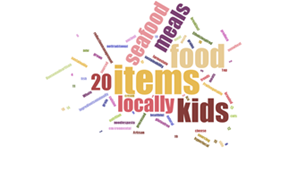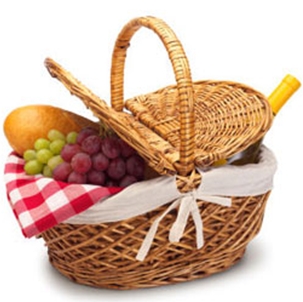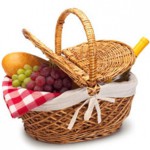by Marjorie Moore | Jul 25, 2015

Photo Source: UF/IFAS Tyler Jones.
Summer brings on the craving to grill and that craving continues through the year! Millions of Americans will enjoy grilling as they gather with family and friends. Whether grilling outdoors or indoors, safe food handling is always important.
When shopping, pick up cold foods such as meat and poultry just before you checkout. Put these foods in plastic bags and keep separate from other foods in your cart. It is wise to have a cooler with ice in your car for all perishables but if not, plan to go directly home. Refrigerate or freeze meat and poultry promptly when you get home.
Thaw meat and poultry in the refrigerator and NEVER on the kitchen counter. For quicker thawing, thaw in the microwave and immediately place on the grill. Thaw meats, fish and poultry completely before grilling. If not thawed completely, the food will not cook evenly.
If marinating meats and poultry, do so in the refrigerator. USDA Food Safety and Inspection Service suggests that poultry and cubed meat may be marinated for up to 2 days and roasts, chops, and steaks marinated up to 5 days. If some of the marinade will be used as a sauce on the cooked food, reserve a portion before putting raw meat and poultry in it. However, if the marinade used on raw meat or poultry is to be reused, make sure to let it come to a boil first to destroy any harmful bacteria.
Use separate utensils, platters, and pans for raw and cooked meat and poultry. Raw juices are high in bacteria and could contaminate safely cooked food.
Never partially cook meat or poultry and save to continue cooking later on the grill. If you do pre-cook, cook these foods completely then cool, refrigerate and reheat later on the grill.
Cook meat such as steaks, roasts, and chops to 145°F. Ground meats such as beef, pork, veal and lamb cooked to 160°F. All poultry, whether whole, pieces or ground, should be cooked to 165°F. Fish and shellfish should be cooked to 145°F.
During the past few years, there have been a few concerns about grilled meats causing cancer.
Some research suggests there may be a cancer risk related to eating meat and poultry cooked by high-heat cooking techniques such as grilling, frying, and broiling. Current research suggest eating moderate amounts of grilled meats, fish, and poultry cooked to a safe temperature, without charring, does not pose a problem. Prevent charring by removing visible fat that can cause a flare-up. Meat can also be precooked immediately before placing on the grill, which helps to release some of the juices that can drop on coals.
So, keep on grilling, but keep your food safe!
Please click here to answer a few questions to help us better serve you.
by Heidi Copeland | Jul 22, 2015

Food Trends word cloud
Upon hearing the word “trend”, you may think fashion. Fact is, foods trend too! Last October, nearly 1,300 members of the American Culinary Federation were given a list of 231 items and asked to rate each item as a hot trend, yesterday’s news or a perennial 2015 favorite. I dare say, many of these leanings, just a couple of years ago, might have been considered a bit unusual. But food trending is neither unusual nor a mere passing. And thanks to those folks embracing the unusual, much of what is now trending becomes the new normal.
I think you will agree that these top 20 food trends are a movement in the right direction:
- Locally sourced meat and seafood
Many consumers are becoming more interested in knowing where their food is coming from.
- Locally grown produce
The definition of locally grown food is not something that is regulated. Local can mean the food comes from around the corner or across the state. Know your farmer, know your food.
- Environmental sustainability
In an ideal farm system, agriculture works in harmony with nature. The idea is that as farmers take from the land, they also give back.
- Healthful kids’ meals
As children grow, help them choose healthy meals and snacks. Eating right helps provide the nutrients needed to be healthy. Teach good eating habits.
- Natural ingredient/minimally processed food
Consumers are demanding “real” foods – fresh, seasonal and less processed. Plus, consumers are seeking to have an impact on improving the environment. This is fueling a demand for what consumers consider to be real food. In fact, major restaurant chains are claiming they too will quit using additives – of any kind. Can you imagine?
- New cuts of meat
Eat a whole animal, leaving nothing but the squeal has made less popular cuts of meat trendy again. An added benefit is that meat processing ranks as one of the most efficient in the food chain – a lot of what is not eaten gets rendered. The animal is broken down into non-edibles that end up in dozens of other products — some of which may surprise you.
- Hyper-local sourcing
In respond to consumer demand for fresher more sustainable foods, some restaurants have begun using ‘hyper-local sourcing’. A good example of hyper-local sourcing would be an on-site or local garden to supplement their kitchens.
- Sustainable seafood
Food & Water Watch has analyzed many different fish and shellfish to create a guide that assess human health and environmental impacts of eating certain seafood, as well as the socio-economic impacts on coastal and fishing communities. http://documents.foodandwaterwatch.org/doc/Seafood_Guide_2013.pdf
- Food waste reduction
Can you believe a few cities in the US make it mandatory for its residents to compost food waste! Demands are much easier to digest knowing that each of us is VERY wasteful…… experts surmise that up to 30% of food produced is thrown away! How can this be helped? Learn to cook. Get organized. Be resourceful! As an example, you can turn yesterday’s leftover vegetables into tomorrow’s breakfast frittata!
- Farm/estate branded items
Although this is just another marketing tool, who doesn’t like something that sounds like it came from a quaint little neighbor’s farm?
- Non-wheat noodles/pasta
Along with the growing popularity of gluten free eating there is growing popularity to consume noodles made from things other than wheat. Have you tried rice, quinoa, mung beans, kelp, sweet potato or zucchini pasta? Many of these non-wheat alternatives are quite tasty and can be made yourself.
Have you seen the spiral cutters or julienne peelers?
- Gluten free cuisine
As stated earlier, one unifying theme for 2015 is grain variety. Many grains do not contain gluten, the protein composite found in wheat and related grains. With a bit of adjustment, gluten free grains can be made into many of the products to which we’ve grown accustom to eating.
- Ancient grains
You know whole grains have gone mainstream when you can purchase everything from chips to smoothies made from whole grains – and I’m not talking wheat, rice and oats. Buckwheat, barley, brown rice flour, quinoa, chia, sorghum and amaranth, flax, and spelt, are all beginning to seem pretty normal.
- Whole grain items in kids meals
Good nutrition can taste good too! Whole grains have also become the norm in school meals.
- Non-traditional fish
As mentioned in number 8, fish is trending. Nutrition Action newsletter has an excellent article worth reading. SOS: Save our Seafood, What’s good for us and the oceans. It was written by Barton Seaver, the director of the Healthy and Sustainable Food Program at the Harvard School of Public Health. http://cspinet.org/new/pdf/cover_story_-_save_our_seafood.pdf
- Ethnic-inspired breakfast items
Meats, fish, cheeses, breads, rice, fruit, vegetables, eggs…..even beans can go here!
- Nutrition
You can learn a lot from a label. Learn how to read one. http://www.fda.gov/Food/IngredientsPackagingLabeling/LabelingNutrition/ucm274593.htm
- House-made/artisan ice cream
In keeping with the whole “food conscientious” theme, even ice cream lovers are opting for fresh, seasonal ingredients. Ice cream is definitely a summer favorite and is best when it’s fresh and homemade!
- Fruit/vegetable kids side items
Fruit and veggies are now available in snack packs! Apparently, even some vending machines are selling baby carrot packs. Not to mention all the frozen smoothie products that contains both fruits and vegetables – without sugar.
- Artisan cheeses
This is a growing niche market and delicious at that! Artisanal cheese refers to cheeses produced by hand using the traditional craftsmanship of skilled cheese makers. Many artisan cheeses can also be called farmstead cheeses, as they are made with milk from the producer’s own herds of cows, sheep, and goats.
The next time you shop for food, give a nod to those early adopters who are embracing the unfamiliar. A considerable amount of the new foods we are seeing and eating today are better for us and better for the environment. This movement is here to stay.
Please click here to answer a few questions to help us better serve you.
by Heidi Copeland | Jul 15, 2015

July is National Ice Cream Month
July: National Ice Cream Month
Why not start this month off with a treat! In 1984, President Ronald Reagan declared July as National Ice Cream Month and the third Sunday in July (July 19th) as National Ice Cream Day! Actually, the whole month of July is supposed to be celebrated with “appropriate ceremonies and activities.” Ice cream is both nutritious and delicious…… eaten in moderation of course, but it can also be confusing. Not all frozen treats are in fact ice cream!
What really is ice cream? Real ice cream or ice-cream is a frozen dessert made from dairy products, such as milk and cream, combined with flavorings and sweeteners, such as sugar. American federal labeling standards require ice cream to contain a minimum of 10% milk fat per 1/2 cup serving and 20% total milk solids by weight. This mixture is stirred slowly while chilling to prevent large ice crystals from forming. A term used in making commercial ice cream is overrun. Overrun means the liquid mixture, once completely chilled can have expanded up to double its original volume by the incorporation of air. This results in a smoothly textured ice cream free from palpable ice crystals or sandiness.
Overrun helps explain the vast price discrepancy between ice cream brands. More expensive brands normally use more and better quality ingredients and have less overrun whereas as less expensive ice cream brands tend to use the minimum amounts of ingredients required by law and more air. Thus, the weight of a half-gallon can indicate quality too.
There are many variations to the basic ice cream recipe. Reading the label of a favorite product helps the consumer learn what is in their favorite brand.
When egg yolk solids are added to ice cream the name has to reflect this. “Frozen custard” or “French ice cream” or “French custard ice cream” is ice cream with the added egg yolk.
Super premium ice cream tends to have higher than standard ice cream recipe. High fat contents and more expensive, best quality ingredients add calories and expense.
Ice milk is not a type of ice cream you see much anymore: it has been replaced by reduced fat products. Years ago ice milk was the low fat version of ice cream. Ice milk is not required to contain the standard minimum of milk fat. However, reduced fat ice cream is required by law to have 25% less fat than that particular company’s regular version. Nonetheless, calories lost here by reducing the milk fat might be made up by other added ingredients such as candy bits. Even light versions of the premium brands can have more fat and calories than plain ice cream. Again, you learn a lot from a label.
Frozen yogurts, made from yogurt, are a dairy product, with the addition various sugars and flavorings. However, yogurt’s reputation for healthfulness is not always accurate and unlike ice cream there are no Federal standards of any kind for frozen yogurt
Gelato is a type of soft ice cream containing a relatively small amount of air. This makes the product dense, rich and creamy. Gelato can be made with milk, cream, various sugars, and flavoring such as fresh fruit. Gelato is generally lower in calories, fat and sugar than ice cream. In the United States there is no standard of definition for gelato set forth by the United States Food and Drug Administration.
Are sorbet, sherbet, and sherbert all the same? Despite the fact that the legal definitions of sorbet and sherbet could be used interchangeably, there is a distinction among American frozen dessert manufacturers. Sherbet — which is alternatively spelled sherbert — is a frozen fruit and dairy product that contains anywhere from 1 percent to 3 percent milk fat from milk or cream. On the other hand, sorbet generally implies a fruit-based frozen dessert with little to no dairy — although the use of the term sorbet is unregulated industry standards want them free from surface crustation, brittleness, syrup bleeding, and large ice crystals.
Confused yet? New to the frozen dessert market are novelty frozen concoctions made with nondairy to mimic ice cream. Welcome, delicious dairy free, soy milk, coconut milk and almond milk frozen desserts. Notice, these products are not called ice-cream but are so smooth and creamy you might not even realize.
In 1984, when President Ronald Regan’s crafted the unique proclamation to eat ice cream folks didn’t have so much to choose from. You do. Enjoy a frozen treat but know what you are buying…….. You can learn a lot from a label.
http://www.icecream.com/icecreaminfo
[Code of Federal Regulations] [Title 21, Volume 2] [Revised as of April 1, 2014] [CITE: 21CFR135.110]
by Elizabeth | Jul 15, 2015

Do your homework on tuition costs before entering college.
The decision to go to college may seem to be a no-brainer, however, paying for the constantly increasing costs of college can be quite challenging. Given the increase of costs to attend a university, most prospective students are driven to borrow money to cover tuition and other costs associated with attending college. Like everything that requires large sums of money, planning and saving is key. Lack of financial planning may result in huge debt loads among young adults aspiring to obtain a college education. Personal financial planning for college tuition should begin as soon as a person enters high school or even earlier. Students should be asking for assistance from counselors who can help them decide both their major in college as well as how to pay for the degree. Doing this earlier will help students become focused and not change majors, which may result in taking more time and classes to graduate, thus requiring more financial assistance.
Before signing any type of financial documents students need to READ the fine print and calculate the cost of borrowing. Here are a list of websites to help you navigate the cost of attending college.
http://www.collegedata.com on this site you can type in a college name and find out the cost of attending that college. By doing this you can decide whether an in-state or out of state college is right for you financially.
The Florida Department of Education, Office of Student Financial Assistance (OSFA) http://www.floridastudentfinancialaid.org/FFELP/ffelp_homepage.html helps you determine what financial aid you qualify for.
The Consumer Financial Protection Bureau (CFPB) website http://www.consumerfinance.gov/students/knowbeforeyouowe/ gives you access to worksheets that you can fill out to compare the different loans available to attend a college.
Armed with information from these sites, you can make an informed decision based on affordability. Graduating with little or no debt at all is ideal, however, not all of us have that opportunity. Therefore, a little homework on tuition costs before entering college may result in less debts upon graduation.

by Judy Corbus | Jun 26, 2015

Photo Credit: Chris Luczkow, www.flickr.com
The bright, beautiful colors of a fireworks displays are a sight to behold and the highlight of July 4 celebrations across the country. But, it’s important to be careful when selecting and using fireworks for your family’s celebration. The National Council on Fireworks Safety offers these consumer safety tips:
- Check and obey local laws regarding what types of fireworks are legal in your area. Laws vary by state and municipality.
- Only buy consumer fireworks from a licensed store, tent, or stand. Never buy fireworks from an individual’s house or from someone on the street. Such devices are likely illegal explosives or professional 1.3G fireworks that can seriously injure you. Illegal explosives are often unpackaged and wrapped in brown paper. They are unlikely to have any safety warnings or the place of manufacture.
- Know your fireworks; read the cautionary labels and performance descriptions before igniting.
- A responsible adult should ALWAYS supervise fireworks activities. Never give fireworks to children.
- Do not consume alcohol while using fireworks.
- Wear safety glasses when shooting fireworks.
- Always have a bucket of water and charged water hose nearby.
- Light one firework at a time and then quickly move away.
- Use fireworks OUTDOORS in a clear area, away from buildings and vehicles.
- Never relight a “dud” firework. Wait 20 minutes and then soak it in a bucket of water.
- Never carry fireworks in your pocket or shoot them into metal or glass containers.
- Do not experiment with homemade fireworks.
- Dispose of spent fireworks by wetting them down and placing in a metal trash can away from any building or combustible materials until the next day.
- FAA regulations PROHIBIT the possession and transportation of fireworks in your checked baggage or carry-on luggage.
- Report illegal explosives, like M-80s, Quarter Sticks, and Cherry Bombs, to your local fire or police department.
Use your fireworks according to instructions and safety warnings and enjoy a safe, happy Fourth of July!
Source: National Council on Fireworks Safety, http://www.fireworksafety.com/

by Dorothy C. Lee | Jun 26, 2015
 It’s that time of year…Summertime! What could be more enjoyable than a summer picnic? Along the Gulf Coast, all you need is a sunny day, white sand beach, and a menu to remember.
It’s that time of year…Summertime! What could be more enjoyable than a summer picnic? Along the Gulf Coast, all you need is a sunny day, white sand beach, and a menu to remember.
However, poor planning can turn a picnic into a small disaster, so first, check the weather forecast because a rainstorm can put a damper on your day.
Keep your food safe. Take only the amounts of food you will use. With a proper cooler and ice, most foods are safe for short periods of time. If you don’t have a cooler, some suggestions for non-perishable foods include fresh, canned, or dried fruits, raw vegetables, hard cheeses, canned or dried meats, crackers, and peanut butter.
Packing pointers: Safe packing of food is essential for picnicking safely. Starting with cold food, pack straight from the refrigerator or freezer into an insulated cooler. Package all foods in clear plastic wrap or zip-top bags. If you don’t have or want to use commercial ice packs, you can make your own by placing ice cubes in a plastic bag, then wrapping the bag in foil.
Sandwiches can be made ahead and frozen, but without veggies and condiments. Place frozen sandwiches in the cooler. They will thaw by lunchtime. Pack lettuce, tomato, and condiments in separate containers and add to sandwiches just before serving. Frozen small cans or boxes of juice, yogurt, or applesauce also will thaw by lunchtime.
Keep hot foods hot with insulated dishes or thermal containers. The rule to remember for safe foods is “Keep cold foods cold and hot foods hot.”
Once you arrive at the picnic site, don’t leave the cooler in the car or in direct sunlight – keep the cooler in the shade, keep the lid on, and avoid frequent openings. Consider using a second cooler just for drinks to reduce the exposure of food to warm air with each lid opening. Add more ice if it begins to melt. In extremely hot weather, food should not sit off refrigeration for more than one hour. Serve small portions so the food doesn’t stay out of the cooler too long.
If you plan to prepare food at the picnic site, keep food cold until you’re ready to cook it. Cook food completely at the site—no partial cooking ahead. Use a clean plate to serve cooked food. Always take care that raw meat juices don’t touch other foods.
Picnics are a great excuse to get together with family and friends. To picnic safely, plan ahead, pack foods carefully, and keep cold foods cold and hot foods hot. Then, relax and have fun!
For further information, contact:
Dorothy C. Lee, C.F.C.S.
UF IFAS Extension Escambia County
3740 Stefani Road
Cantonment, FL 32533-7792
(850) 475-5230
dclee@ufl.edu








